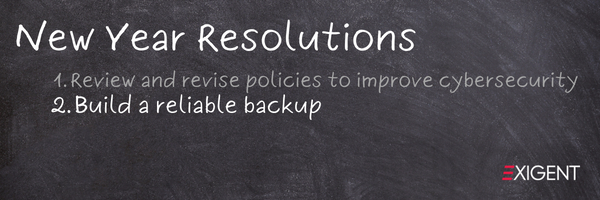A new concept hit the technology industry last year: Cyber resiliency. The idea is that cybersecurity products alone aren't enough to protect valuable assets and data. Instead, it takes a 360-degree approach that includes policies, cybersecurity solutions, security awareness training, incident response planning, cyber insurance, and a reliable business continuity strategy. Within that multifaceted approach, you will find an old standby—data backup and disaster recovery planning.
Key Takeaways
- Follow the 3-2-1 rule for backups: Maintain three copies of your data, on two different media types, with one offsite to ensure resilience.
- Test, don't guess: Regularly test your backups and recovery plan to avoid surprises during a real disaster.
- Secure backups with strong access controls: Use encryption, role-based access, and MFA to protect sensitive data from internal and external threats.
Resolution #2 may seem simple, but it is essential. Let's build a more reliable backup and recovery plan for your small to mid-sized business (SMB). As a starting point, here are five tips for creating an effective data backup plan for SMBs:
1. Research and Craft Your Plan
This may seem obvious, but many organizations either fail to thoroughly plan their backup strategy or don't have a process for revisiting and revising that plan as their business grows. That can mean overlooking new sources of data, failing to update procedures, and in general, finding out the hard way that backup may not be doing all it is supposed to.
To create an effective business data protection plan:
- Identify and prioritize data: Identify where all your data resides, then categorize and prioritize it based on how critical it is and the recovery time objective (RTO) for that information. The more important the data, the more frequent the backup cycle should be. Some examples of highly valuable data would be customer data, financial records, business plans, proprietary documents, and other mission-critical information.
- Choose a backup method: Depending on the type, size, and sensitivity of your organization's information, not all solutions will work well so be certain you thoroughly research options. Best practices suggest a 3-2-1 rule: Have three copies of your data stored on two different media types (for example, a local hard drive and cloud storage), with one copy stored offsite for disaster recovery.
- Set a schedule for backups: Define backup frequencies based on data criticality. Critical data might need daily backups, while less critical data could be backed up weekly or monthly. As with many repetitive tasks, automating backups reduces the possibility of human error and provides consistency with little to no oversight.
- Test your backups: Let's say it again for the folks in the back! Regularly test your backups to make sure they are working as expected, the data is recoverable, and you can restore critical data quickly and reliably. This is an opportunity to fine-tune your backup and recovery process over time to achieve efficiency and reduce risk.
2. Utilize the Cloud
Some smaller organizations remain hesitant about the cloud, but it is hard to argue about the affordable, accessible option cloud backup provides small businesses. Plus, cloud backup offers quick scalability (up or down), which can be helpful to high-growth organizations. Most cloud providers offer enterprise-class cybersecurity and have their own sophisticated, redundant disaster recovery plans, offering additional protection within your backup strategy. Cloud plays a crucial role in the 3-2-1 backup and recovery tactic, supporting a hybrid backup approach that combines local and cloud backups for greater redundancy. Evaluating and considering cost-effective cloud backup solutions for SMBs should be part of your strategy.
Interested in learning why and how you should leverage cloud-to-cloud backup? Let's talk about our Backupify solution for Google Workplace and Microsoft 265.
3. Implement Advanced Business Data Security
Keeping your invaluable data protected during the backup and recovery process can be a challenge. The best way to achieve that is encryption. To further safeguard business data both at rest and in transit and protect sensitive information from unauthorized access, you should take several steps:
- Implement strong passwords
- Require multifactor authentication at each step
- Encrypt business data both at rest and while transferring
- Use role-based access controls
- Keep software patched and updated
One element of data protection that is easily overlooked in data backup and recovery planning is access control—who can set, change, or delete backups? Be certain that only authorized personnel can modify or delete backup settings and data. Zero-trust security measures should be in place for business data security.
Extra Tip: Understand Regulatory Compliance Requirements
If you are one of the many small to mid-size organizations that are regulated by compliance standards such as HIPAA or SOX, you need to account for the stringent data protection and retention requirements required by those laws. Non-compliance can lead to substantial fines and legal liabilities. Most compliance standards require specific data security, backup, and retention policies, so be certain your data backup not only meets these obligations but the process is thoroughly captured in documentation.
4. Develop a Recovery Plan
Now that you've successfully and securely backed up critical data, you still need to craft and implement a comprehensive data recovery plan, because retrieving that data is just as important as protecting it. The recovery plan should meticulously outline the steps to take in the event of data loss, including contact information for your MSP and other service providers, and for the key internal people responsible for guiding recovery efforts. As you design this plan, revisit the data prioritization and RTO overview in the first step of backup planning, making sure recovery of mission-critical data takes precedence. Take the time to test your recovery plan just as you did your backup process and set up mock disaster recovery exercises so everyone involved in the recovery process understands what will happen and their responsibilities. Trust us, you do not want to try this the first time during a cyber attack or natural disaster.
Download our Disaster Recovery Planning Checklist
5. Train Employees
Explaining and testing your data backup and recovery plan with the immediate team who will run it isn't enough. Take the time to thoroughly educate employees on the backup and recovery process and revisit the strategy regularly so your team is comfortable with the steps. During these trainings, focus on explaining the importance of backups, the roles they play in data recovery, and reporting procedures for potential data breaches. Don't overlook this opportunity to train employees on data security best practices, remind them of the need for constant vigilance around cybersecurity, and share top tips for protecting business data from cyberattacks.
By following these best practices, you will take a huge step toward creating an effective data backup and recovery plan for your small business, ensuring crucial business data is safe, secure, and readily available no matter what type of disaster strikes. Remember, data backup is not a "one-and-done" effort, but an ongoing process that requires review and refinement over time.



